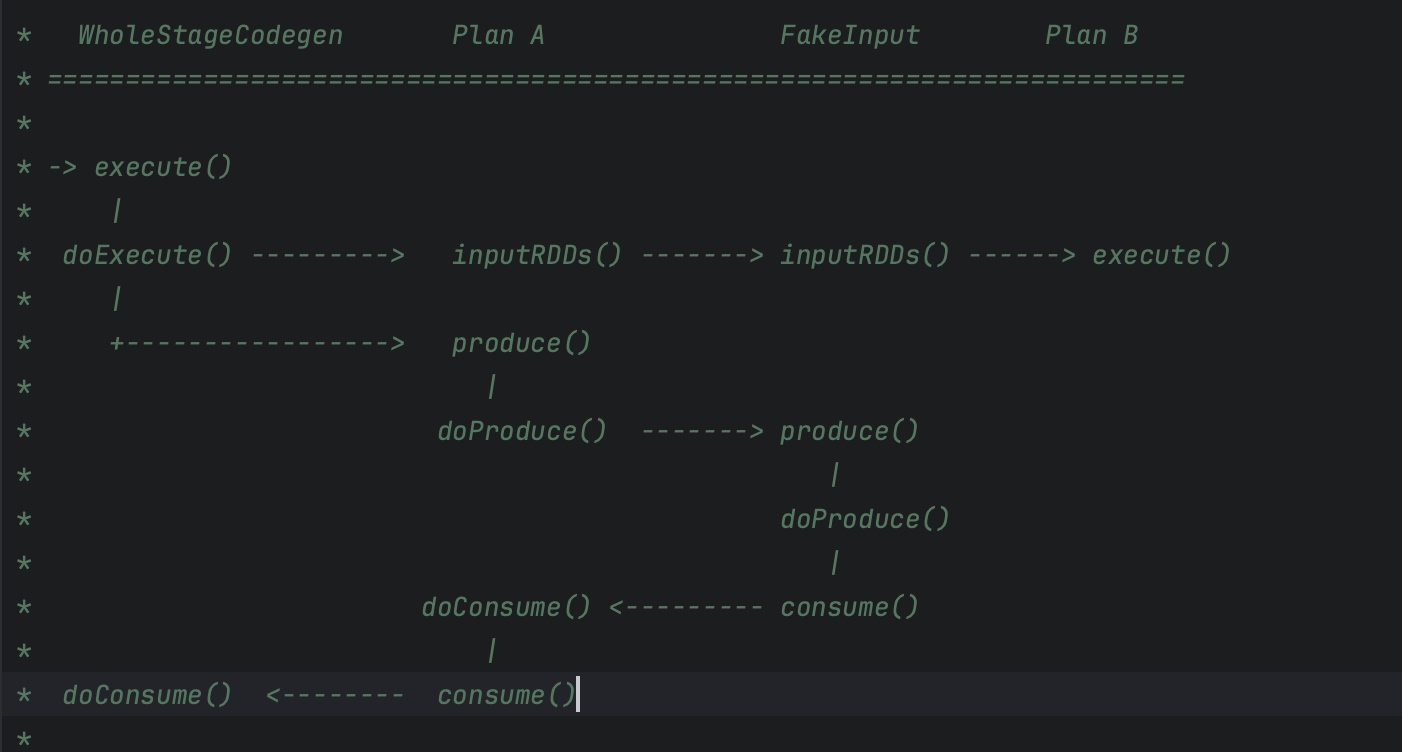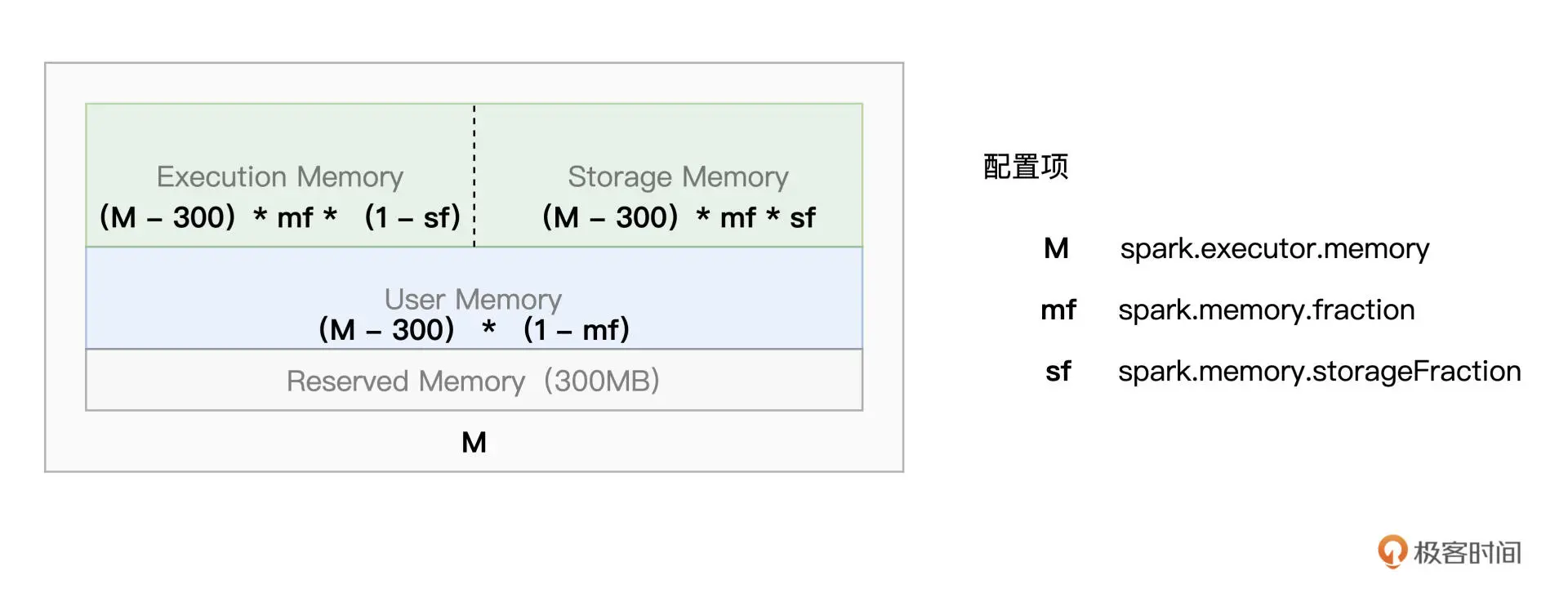15721这一章没什么好说的,不再贴课程内容了。codegen和simd在工业界一般只会选一种实现。比如phothon之前用codegen,然后改成了向量化引擎。一般gen的都是weld IR/LLVM IR/当前语言,gen成C++的也要检查是不是有本地预编译版本,要不没法用。因为clickhouse没有codegen,这节课就拿我比较熟悉的spark的tungsten来当例子,tungsten会gen成scala,然后拿janino动态编译。
tungsten主要有两个特色:一个是codegen,另一个是in-heap memory的管理。本文顺便把它的内存管理也分析一下。在jvm堆内自由分配内存,不被free,不受gc影响,还是挺有意思的。
WASG
手写代码的生成过程分为两个步骤:
- 从父节点到子节点,递归调用 doProduce,生成框架
- 从子节点到父节点,递归调用 doConsume,向框架填充每一个操作符的运算逻辑

首先,在 Stage 顶端节点也就是 Project 之上,添加 WholeStageCodeGen 节点。WholeStageCodeGen 节点通过调用 doExecute 来触发整个代码生成过程的计算。doExecute 会递归调用子节点的 doProduce 函数,直到遇到 Shuffle Boundary 为止。这里,Shuffle Boundary 指的是 Shuffle 边界,要么是数据源,要么是上一个 Stage 的输出。在叶子节点(也就是 Scan)调用的 doProduce 函数会先把手写代码的框架生成出来。
override def doExecute(): RDD[InternalRow] = {// 下面这一行将会调用子类的produce完成上述过程。val (ctx, cleanedSource) = doCodeGen()// try to compile and fallback if it failed// 调用janino完成动态编译过程val (_, compiledCodeStats) = try {CodeGenerator.compile(cleanedSource)} catch {case NonFatal(_) if !Utils.isTesting && conf.codegenFallback =>// We should already saw the error messagelogWarning(s"Whole-stage codegen disabled for plan (id=$codegenStageId):\n $treeString")return child.execute()}// Check if compiled code has a too large functionif (compiledCodeStats.maxMethodCodeSize > conf.hugeMethodLimit) {logInfo(s"Found too long generated codes and JIT optimization might not work: " +s"the bytecode size (${compiledCodeStats.maxMethodCodeSize}) is above the limit " +s"${conf.hugeMethodLimit}, and the whole-stage codegen was disabled " +s"for this plan (id=$codegenStageId). To avoid this, you can raise the limit " +s"`${SQLConf.WHOLESTAGE_HUGE_METHOD_LIMIT.key}`:\n$treeString")return child.execute()}val references = ctx.references.toArrayval durationMs = longMetric("pipelineTime")// Even though rdds is an RDD[InternalRow] it may actually be an RDD[ColumnarBatch] with// type erasure hiding that. This allows for the input to a code gen stage to be columnar,// but the output must be rows.val rdds = child.asInstanceOf[CodegenSupport].inputRDDs()assert(rdds.size <= 2, "Up to two input RDDs can be supported")if (rdds.length == 1) {rdds.head.mapPartitionsWithIndex { (index, iter) =>val (clazz, _) = CodeGenerator.compile(cleanedSource)val buffer = clazz.generate(references).asInstanceOf[BufferedRowIterator]buffer.init(index, Array(iter))new Iterator[InternalRow] {override def hasNext: Boolean = {val v = buffer.hasNextif (!v) durationMs += buffer.durationMs()v}override def next: InternalRow = buffer.next()}}} else {// Right now, we support up to two input RDDs.rdds.head.zipPartitions(rdds(1)) { (leftIter, rightIter) =>Iterator((leftIter, rightIter))// a small hack to obtain the correct partition index}.mapPartitionsWithIndex { (index, zippedIter) =>val (leftIter, rightIter) = zippedIter.next()val (clazz, _) = CodeGenerator.compile(cleanedSource)val buffer = clazz.generate(references).asInstanceOf[BufferedRowIterator]buffer.init(index, Array(leftIter, rightIter))new Iterator[InternalRow] {override def hasNext: Boolean = {val v = buffer.hasNextif (!v) durationMs += buffer.durationMs()v}override def next: InternalRow = buffer.next()}}}} def doCodeGen(): (CodegenContext, CodeAndComment) = {val startTime = System.nanoTime()val ctx = new CodegenContextval code = child.asInstanceOf[CodegenSupport].produce(ctx, this)// main next function.ctx.addNewFunction("processNext",s"""protected void processNext() throws java.io.IOException {${code.trim}}""", inlineToOuterClass = true)val className = generatedClassName()val source = s"""public Object generate(Object[] references) {return new $className(references);}${ctx.registerComment(s"""Codegened pipeline for stage (id=$codegenStageId)|${this.treeString.trim}""".stripMargin,"wsc_codegenPipeline")}${ctx.registerComment(s"codegenStageId=$codegenStageId", "wsc_codegenStageId", true)}final class $className extends ${classOf[BufferedRowIterator].getName} {private Object[] references;private scala.collection.Iterator[] inputs;${ctx.declareMutableStates()}public $className(Object[] references) {this.references = references;}public void init(int index, scala.collection.Iterator[] inputs) {partitionIndex = index;this.inputs = inputs;${ctx.initMutableStates()}${ctx.initPartition()}}${ctx.emitExtraCode()}${ctx.declareAddedFunctions()}}""".trim// try to compile, helpful for debugval cleanedSource = CodeFormatter.stripOverlappingComments(new CodeAndComment(CodeFormatter.stripExtraNewLines(source), ctx.getPlaceHolderToComments()))val duration = System.nanoTime() - startTimeWholeStageCodegenExec.increaseCodeGenTime(duration)logDebug(s"\n${CodeFormatter.format(cleanedSource)}")(ctx, cleanedSource)}
然后,Scan 中的 doProduce 会反向递归调用每个父节点的 doConsume 函数。不同操作符在执行 doConsume 函数的过程中,会把关系表达式转化成 Java 代码,然后把这份代码像做“完形填空”一样,嵌入到刚刚的代码框架里。
doConsume代码不太好理解,我们以filter为例:
override def doConsume(ctx: CodegenContext, input: Seq[ExprCode], row: ExprCode): String = {val numOutput = metricTerm(ctx, "numOutputRows")val predicateCode = generatePredicateCode(ctx, child.output, input, output, notNullPreds, otherPreds, notNullAttributes)// Reset the isNull to false for the not-null columns, then the followed operators could// generate better code (remove dead branches).val resultVars = input.zipWithIndex.map { case (ev, i) =>if (notNullAttributes.contains(child.output(i).exprId)) {ev.isNull = FalseLiteral}ev}// Note: wrap in "do { } while(false);", so the generated checks can jump out with "continue;"s"""|do {| $predicateCode| $numOutput.add(1);| ${consume(ctx, resultVars)}|} while(false);""".stripMargin}protected def generatePredicateCode(ctx: CodegenContext,inputAttrs: Seq[Attribute],inputExprCode: Seq[ExprCode],outputAttrs: Seq[Attribute],notNullPreds: Seq[Expression],otherPreds: Seq[Expression],nonNullAttrExprIds: Seq[ExprId]): String = {/*** Generates code for `c`, using `in` for input attributes and `attrs` for nullability.*/def genPredicate(c: Expression, in: Seq[ExprCode], attrs: Seq[Attribute]): String = {val bound = BindReferences.bindReference(c, attrs)val evaluated = evaluateRequiredVariables(inputAttrs, in, c.references)// Generate the code for the predicate.val ev = ExpressionCanonicalizer.execute(bound).genCode(ctx)val nullCheck = if (bound.nullable) {s"${ev.isNull} || "} else {s""}s"""|$evaluated|${ev.code}|if (${nullCheck}!${ev.value}) continue;""".stripMargin}// To generate the predicates we will follow this algorithm.// For each predicate that is not IsNotNull, we will generate them one by one loading attributes// as necessary. For each of both attributes, if there is an IsNotNull predicate we will// generate that check *before* the predicate. After all of these predicates, we will generate// the remaining IsNotNull checks that were not part of other predicates.// This has the property of not doing redundant IsNotNull checks and taking better advantage of// short-circuiting, not loading attributes until they are needed.// This is very perf sensitive.// TODO: revisit this. We can consider reordering predicates as well.val generatedIsNotNullChecks = new Array[Boolean](notNullPreds.length)val extraIsNotNullAttrs = mutable.Set[Attribute]()val generated = otherPreds.map { c =>val nullChecks = c.references.map { r =>val idx = notNullPreds.indexWhere { n => n.asInstanceOf[IsNotNull].child.semanticEquals(r)}if (idx != -1 && !generatedIsNotNullChecks(idx)) {generatedIsNotNullChecks(idx) = true// Use the child's output. The nullability is what the child produced.genPredicate(notNullPreds(idx), inputExprCode, inputAttrs)} else if (nonNullAttrExprIds.contains(r.exprId) && !extraIsNotNullAttrs.contains(r)) {extraIsNotNullAttrs += rgenPredicate(IsNotNull(r), inputExprCode, inputAttrs)} else {""}}.mkString("\n").trim// Here we use *this* operator's output with this output's nullability since we already// enforced them with the IsNotNull checks above.s"""|$nullChecks|${genPredicate(c, inputExprCode, outputAttrs)}""".stripMargin.trim}.mkString("\n")val nullChecks = notNullPreds.zipWithIndex.map { case (c, idx) =>if (!generatedIsNotNullChecks(idx)) {genPredicate(c, inputExprCode, inputAttrs)} else {""}}.mkString("\n")s"""|$generated|$nullChecks""".stripMargin}
}这个地方先裁剪再判断,首先对涉及到谓词的is not null生成判断,之后进行裁剪,然后对裁剪后的列没有覆盖到is not null的再做一次is not null。这里的性能比较关键。
对于以下sql:
SELECT department, AVG(salary) AS avg_salary
FROM employee
GROUP BY department
HAVING AVG(salary) > 60000
生成效果如下:
generated:
boolean filter_value_2 = !hashAgg_isNull_11;
if (!filter_value_2) continue;boolean filter_value_3 = false;
filter_value_3 = org.apache.spark.sql.catalyst.util.SQLOrderingUtil.compareDoubles(hashAgg_value_11, 60000.0D) > 0;
if (!filter_value_3) continue;
如果加上一句where salary IS NOT NULL,那么在hashAgg之前,还会插入一段null的判断:
boolean rdd_isNull_3 = rdd_row_0.isNullAt(3);
double rdd_value_3 = rdd_isNull_3 ?-1.0 : (rdd_row_0.getDouble(3));boolean filter_value_2 = !rdd_isNull_3;
if (!filter_value_2) continue;
内存管理
tungsten memory management

这里的idea很简单,重构对象模型但是不改变gc逻辑,于是tungsten抽象出了page table,来存放大量java native object,page table地址还是由jvm进行管理,拿到地址后在jvm堆内查找。
spark-core
在看spark-unsafe中的tungsten分配器之前, 我们先看下spark-core中的内存管理模块,
我们可以看到MemoryManager中的分配器已经默认换成了tungsten
/*** Allocates memory for use by Unsafe/Tungsten code.*/private[memory] final val tungstenMemoryAllocator: MemoryAllocator = {tungstenMemoryMode match {case MemoryMode.ON_HEAP => MemoryAllocator.HEAPcase MemoryMode.OFF_HEAP => MemoryAllocator.UNSAFE}}MemoryManager就是用来管理Execution和Storage之间内存分配的类。

Execution和Storage都有堆内和堆外内存,使用内存池的方式由MemoryManager进行管理。
@GuardedBy("this")protected val onHeapStorageMemoryPool = new StorageMemoryPool(this, MemoryMode.ON_HEAP)@GuardedBy("this")protected val offHeapStorageMemoryPool = new StorageMemoryPool(this, MemoryMode.OFF_HEAP)@GuardedBy("this")protected val onHeapExecutionMemoryPool = new ExecutionMemoryPool(this, MemoryMode.ON_HEAP)@GuardedBy("this")protected val offHeapExecutionMemoryPool = new ExecutionMemoryPool(this, MemoryMode.OFF_HEAP)
对于tungsten的实际调用在TaskMMemoryManager中:
// 调用ExecutorMemoryManager进行内存分配,分配得到一个内存页,将其添加到
// page table中,用于内存地址映射
/*** Allocate a block of memory that will be tracked in the MemoryManager's page table; this is* intended for allocating large blocks of memory that will be shared between operators.*/public MemoryBlock allocatePage(long size) {if (size > MAXIMUM_PAGE_SIZE_BYTES) {throw new IllegalArgumentException("Cannot allocate a page with more than " + MAXIMUM_PAGE_SIZE_BYTES + " bytes");}final int pageNumber;synchronized (this) {// allocatedPages是一个bitmap// PAGE_TABLE_SIZE是两个内存页 8KBpageNumber = allocatedPages.nextClearBit(0);if (pageNumber >= PAGE_TABLE_SIZE) {throw new IllegalStateException("Have already allocated a maximum of " + PAGE_TABLE_SIZE + " pages");}allocatedPages.set(pageNumber);}try {page = memoryManager.tungstenMemoryAllocator().allocate(acquired);} catch (OutOfMemoryError e) {// 继续清理直到满足需要logger.warn("Failed to allocate a page ({} bytes), try again.", acquired);// there is no enough memory actually, it means the actual free memory is smaller than// MemoryManager thought, we should keep the acquired memory.synchronized (this) {acquiredButNotUsed += acquired;allocatedPages.clear(pageNumber);}// this could trigger spilling to free some pages.return allocatePage(size, consumer);}page.pageNumber = pageNumber;pageTable[pageNumber] = page;if (logger.isTraceEnabled()) {logger.trace("Allocate page number {} ({} bytes)", pageNumber, size);}return page;}给定分配到的内存页和页内的偏移,生成一个64bits的逻辑地址/*** Given a memory page and offset within that page, encode this address into a 64-bit long.* This address will remain valid as long as the corresponding page has not been freed.** @param page a data page allocated by {@link TaskMemoryManager#allocate(long)}.* @param offsetInPage an offset in this page which incorporates the base offset. In other words,* this should be the value that you would pass as the base offset into an* UNSAFE call (e.g. page.baseOffset() + something).* @return an encoded page address.*/public long encodePageNumberAndOffset(MemoryBlock page, long offsetInPage) {if (!inHeap) {// In off-heap mode, an offset is an absolute address that may require a full 64 bits to// encode. Due to our page size limitation, though, we can convert this into an offset that's// relative to the page's base offset; this relative offset will fit in 51 bits.offsetInPage -= page.getBaseOffset();}return encodePageNumberAndOffset(page.pageNumber, offsetInPage);}高13bits是page number,低位为页内偏移@VisibleForTestingpublic static long encodePageNumberAndOffset(int pageNumber, long offsetInPage) {assert (pageNumber != -1) : "encodePageNumberAndOffset called with invalid page";return (((long) pageNumber) << OFFSET_BITS) | (offsetInPage & MASK_LONG_LOWER_51_BITS);}给定逻辑地址,获取page number@VisibleForTestingpublic static int decodePageNumber(long pagePlusOffsetAddress) {return (int) ((pagePlusOffsetAddress & MASK_LONG_UPPER_13_BITS) >>> OFFSET_BITS);}给定逻辑地址,获取页内偏移private static long decodeOffset(long pagePlusOffsetAddress) {return (pagePlusOffsetAddress & MASK_LONG_LOWER_51_BITS);}给定地址,获取内存页/*** Get the page associated with an address encoded by* {@link TaskMemoryManager#encodePageNumberAndOffset(MemoryBlock, long)}*/public Object getPage(long pagePlusOffsetAddress) {if (inHeap) {final int pageNumber = decodePageNumber(pagePlusOffsetAddress);assert (pageNumber >= 0 && pageNumber < PAGE_TABLE_SIZE);final MemoryBlock page = pageTable[pageNumber];assert (page != null);assert (page.getBaseObject() != null);return page.getBaseObject();} else {return null;}}给定地址获取页内偏移/*** Get the offset associated with an address encoded by* {@link TaskMemoryManager#encodePageNumberAndOffset(MemoryBlock, long)}*/public long getOffsetInPage(long pagePlusOffsetAddress) {final long offsetInPage = decodeOffset(pagePlusOffsetAddress);if (inHeap) {return offsetInPage;} else {// In off-heap mode, an offset is an absolute address. In encodePageNumberAndOffset, we// converted the absolute address into a relative address. Here, we invert that operation:final int pageNumber = decodePageNumber(pagePlusOffsetAddress);assert (pageNumber >= 0 && pageNumber < PAGE_TABLE_SIZE);final MemoryBlock page = pageTable[pageNumber];assert (page != null);return page.getBaseOffset() + offsetInPage;}}
spark-storage
spark-storage中类的关系比较复杂,不在这里展开,列一下几个重要类:
- BlockId:
表示 Spark 中数据块的唯一标识符。
依赖关系:通常作为其他存储相关类的参数或属性,例如 BlockManager。
- BlockInfo:
包含有关数据块的元数据信息。
依赖关系:依赖于 BlockId,并且可以与 BlockManager 一起使用。
- BlockManager:
负责管理分布式数据块的存储和检索。
依赖关系:依赖于 BlockId、BlockInfo 等类,与 DiskStore、MemoryStore 等一起协同工作。
- BlockManagerMaster:
管理集群中所有 BlockManager 的主节点。
依赖关系:依赖于 BlockManager,与 BlockManagerId 等协同工作。
- BlockManagerId:
表示 BlockManager 的唯一标识符。
依赖关系:通常作为 BlockManagerMaster 的参数,用于标识不同的 BlockManager。
- BlockManagerMasterEndpoint:
BlockManagerMaster 与其他节点通信的端点。
依赖关系:依赖于 BlockManagerMaster,与 RpcEndpoint 等一起使用。
- DiskBlockManager:
BlockManager 的一个实现,负责将数据块持久化到磁盘。
依赖关系:依赖于 BlockManager 和 DiskStore,与 DiskStore 等一起工作。
- MemoryStore:
BlockManager 中负责将数据块存储在内存中的组件。
依赖关系:依赖于 BlockManager 和 MemoryManager,与 MemoryManager 等协同工作。
- DiskStore:
BlockManager 中负责将数据块持久化到磁盘的组件。
依赖关系:依赖于 BlockManager 和 DiskBlockManager。
- MemoryManager:
负责管理内存的组件,与 MemoryStore 等协同工作。
依赖关系:通常与 MemoryStore 和 BlockManager 一起使用。
- ShuffleBlockId:
用于表示与Shuffle相关的数据块的标识符。
依赖关系:依赖于 BlockId。
spark-unsafe
HeapMemoryAllocator实现了堆内存的实际分配
@GuardedBy("this")private final Map<Long, LinkedList<WeakReference<long[]>>> bufferPoolsBySize = new HashMap<>();private static final int POOLING_THRESHOLD_BYTES = 1024 * 1024;/*** Returns true if allocations of the given size should go through the pooling mechanism and* false otherwise.*/private boolean shouldPool(long size) {// Very small allocations are less likely to benefit from pooling.return size >= POOLING_THRESHOLD_BYTES;}这里使用一个弱引用的Long数组对于1M以上的回收内存进行资源池化,弱引用为了避免长时间未使用的数组一直保留在缓冲池中,消耗内存资源。
这也是spark内存使用不稳定的原因之一:弱引用对象的回收仍然是jvm控制的,没办法做到立即回收。
@Overridepublic MemoryBlock allocate(long size) throws OutOfMemoryError {int numWords = (int) ((size + 7) / 8);long alignedSize = numWords * 8L;assert (alignedSize >= size);if (shouldPool(alignedSize)) {synchronized (this) {final LinkedList<WeakReference<long[]>> pool = bufferPoolsBySize.get(alignedSize);if (pool != null) {while (!pool.isEmpty()) {final WeakReference<long[]> arrayReference = pool.pop();final long[] array = arrayReference.get();if (array != null) {assert (array.length * 8L >= size);MemoryBlock memory = new MemoryBlock(array, Platform.LONG_ARRAY_OFFSET, size);if (MemoryAllocator.MEMORY_DEBUG_FILL_ENABLED) {memory.fill(MemoryAllocator.MEMORY_DEBUG_FILL_CLEAN_VALUE);}return memory;}}bufferPoolsBySize.remove(alignedSize);}}}long[] array = new long[numWords];MemoryBlock memory = new MemoryBlock(array, Platform.LONG_ARRAY_OFFSET, size);if (MemoryAllocator.MEMORY_DEBUG_FILL_ENABLED) {memory.fill(MemoryAllocator.MEMORY_DEBUG_FILL_CLEAN_VALUE);}return memory;}free的时候如果大于1M,则池化,否则清空引用
@Overridepublic void free(MemoryBlock memory) {assert (memory.obj != null) :"baseObject was null; are you trying to use the on-heap allocator to free off-heap memory?";assert (memory.pageNumber != MemoryBlock.FREED_IN_ALLOCATOR_PAGE_NUMBER) :"page has already been freed";assert ((memory.pageNumber == MemoryBlock.NO_PAGE_NUMBER)|| (memory.pageNumber == MemoryBlock.FREED_IN_TMM_PAGE_NUMBER)) :"TMM-allocated pages must first be freed via TMM.freePage(), not directly in allocator " +"free()";final long size = memory.size();if (MemoryAllocator.MEMORY_DEBUG_FILL_ENABLED) {memory.fill(MemoryAllocator.MEMORY_DEBUG_FILL_FREED_VALUE);}// Mark the page as freed (so we can detect double-frees).memory.pageNumber = MemoryBlock.FREED_IN_ALLOCATOR_PAGE_NUMBER;// As an additional layer of defense against use-after-free bugs, we mutate the// MemoryBlock to null out its reference to the long[] array.long[] array = (long[]) memory.obj;memory.setObjAndOffset(null, 0);long alignedSize = ((size + 7) / 8) * 8;if (shouldPool(alignedSize)) {synchronized (this) {LinkedList<WeakReference<long[]>> pool =bufferPoolsBySize.computeIfAbsent(alignedSize, k -> new LinkedList<>());pool.add(new WeakReference<>(array));}}}

)

)










:长度最小的子数组)


)
torch.optim.SGD-随机梯度下降法)
